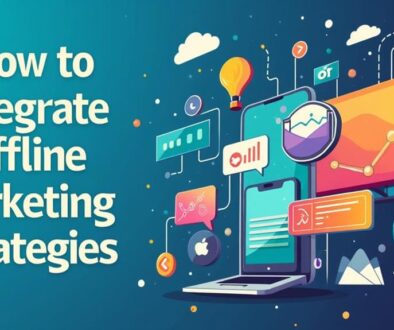How to Develop a Marketing Strategy for E-Commerce Businesses
To develop a robust marketing strategy for e-commerce businesses, start by understanding your target audience through demographic and psychographic analysis. Set clear, SMART goals that align with your brand identity. Analyze competitor strategies to identify market gaps and differentiation opportunities. Select a multifaceted marketing approach, utilizing channels like social media, email, and content marketing. Prioritize compelling content creation to engage customers emotionally. Implement SEO best practices to enhance visibility and optimize user experience. Ultimately, continuously measure performance metrics to refine strategies. This foundational knowledge sets the stage for innovative tactics that will elevate your e-commerce brand.
Key Takeaways
- Understand your target audience through demographic and psychographic profiling to tailor marketing strategies effectively.
- Set SMART goals to align resource management and enhance brand messaging for sustainable growth.
- Analyze competitor strategies to identify market gaps and develop effective positioning tactics.
- Choose multifaceted marketing channels like social media, email, and affiliate marketing to broaden audience reach.
- Utilize SEO best practices and data analytics tools to optimize website performance and measure marketing effectiveness.
Understand Your Target Audience

How well do you truly know your target audience? In the dynamic domain of e-commerce, understanding your audience is not merely an exercise in demographic profiling; it is a strategic imperative that propels success. Developing a nuanced comprehension of consumer behavior allows businesses to tailor offerings, marketing strategies, and communications that resonate deeply with potential buyers.
Demographic profiling is a fundamental tool in this endeavor, encompassing variables such as age, gender, income, and location. However, reliance solely on these statistics can yield a superficial view. To reveal true potential, one must explore deeper—examining psychographics, motivations, and values that dictate consumer choices. This innovative approach emphasizes the individual rather than lumping them into sterile categories, thereby fostering a more personalized connection.
By systematically analyzing consumer behavior, e-commerce businesses can identify not only who their target audience is but why they make purchasing decisions. This insight informs every aspect of the business, from product development to marketing campaigns, ultimately leading to a more profound engagement.
Audiences that yearn for freedom expect brands to understand their unique needs and aspirations. Fostering this connection can create loyalty that transcends transactions, positioning your business as a trusted ally in their journey.
In essence, a robust understanding of your audience, informed by thorough demographic profiling and consumer behavior analysis, will empower your e-commerce enterprise to innovate and thrive amid competitive pressures. Embrace this knowledge to forge paths that lead to genuine and enduring relationships.
Set Clear Goals and Objectives
Establishing clear goals and objectives is essential for e-commerce businesses seeking to navigate the complexities of the digital marketplace effectively. Without well-defined targets, efforts may become unfocused, leading to wasted resources and missed opportunities. Goals should align seamlessly with the company's brand identity and values, ensuring brand alignment. When the objectives are in harmony with the brand, it fosters a unified message that resonates with customers, enhancing overall engagement.
Effective goal-setting involves the SMART criteria: Specific, Measurable, Achievable, Relevant, and Time-bound. For instance, instead of a vague objective like "improve sales," a well-defined goal would be "increase online sales by 20% in the next quarter through targeted social media campaigns." This specificity not only provides a clear direction but also facilitates tracking progress and adjusting strategies as necessary.
Additionally, consider goals that enhance customer engagement. Engaging your audience post-purchase can cultivate loyalty, leading to repeat business. Objectives such as increasing email open rates by 15% or boosting social media interaction by 25% can drive customer connection and feedback.
In essence, goals and objectives provide the framework for advancing an e-commerce business's strategies. By focusing on brand alignment and customer engagement, e-commerce businesses can build robust strategies that not only achieve desired outcomes but also embody the freedom and innovation that the digital landscape offers.
As these goals guide daily operations and long-term vision, they transform abstract aspirations into actionable plans, facilitating sustainable growth.
Analyze Competitor Strategies

With clear goals and objectives serving as a foundation, the next step involves examining competitor strategies to gain a competitive edge in the e-commerce landscape. Conducting thorough competitor analysis allows businesses to understand their market positioning, identify gaps, and formulate strategies to differentiate their brand effectively.
To maximize insights from this analysis, consider focusing on the following key areas:
- Pricing Strategies: Evaluate competitor pricing models and offer insights into their approach. This might reveal opportunities for flexible pricing or bundling that could enhance customer retention and loyalty.
- Promotional Tactics: Take note of the promotional tactics employed by competitors. Analyze their use of advertising channels, including social media presence, email marketing, and influencer partnerships, to determine what resonates with their audience.
- Strengths and Weaknesses: Identify the strengths and weaknesses of competitors. This insight can illuminate areas where your business can excel, such as providing superior customer service or innovative product offerings, thereby capturing additional market share.
Choose Marketing Channels
Selecting the most effective marketing channels is vital for e-commerce businesses aiming to reach their target audience and drive conversions. A multifaceted approach is often required, as diverse channels offer unique advantages.
Social media platforms remain essential, facilitating community engagement while allowing businesses to build robust relationships with potential customers. With the viral nature of platforms like Instagram and TikTok, influencer partnerships can amplify brand visibility and authenticity.
Email marketing stands as another cornerstone, presenting an opportunity for personalized communication that nurtures leads and fosters loyalty. By implementing effective segmentation strategies, businesses can tailor their messaging to resonate with individual preferences.
Moreover, affiliate programs leverage third-party endorsements, enabling brands to tap into new audiences through trusted voices.
Search engine marketing and paid advertising extend reach beyond organic options, driving immediate traffic to your website. Complementing this approach, mobile advertising guarantees accessibility, given the increasing reliance on smartphones for online shopping.
Exploring innovative methods such as podcast promotion can also engage potential customers in an intimate, informative format, additionally enhancing brand familiarity.
Content marketing remains paramount, as it serves to educate and inform your audience, positioning your brand as an industry leader.
Develop Compelling Content

In today's competitive e-commerce landscape, developing compelling content is essential for capturing the attention of potential customers.
Utilizing storytelling in marketing not only engages audiences on an emotional level but also enhances brand loyalty.
Additionally, integrating high-quality visual content serves to communicate messages more efficiently, making it a critical component of any effective marketing strategy.
Storytelling in Marketing
How can storytelling transform the way e-commerce businesses engage with their customers?
Storytelling allows brands to create a compelling brand narrative that resonates deeply with consumers, fostering an emotional connection that is pivotal throughout the customer journey.
By embracing authentic storytelling, businesses can craft experiences that not only highlight their products but also the values and aspirations behind them.
To effectively harness storytelling in your marketing strategy, consider the following elements:
- Narrative Consistency: Ascertain that your brand voice remains cohesive across all platforms, reinforcing your core message and values.
- Thematic Elements: Identify themes that matter to your audience, weaving them into your content to enhance relatability and emotional engagement.
- Storytelling Formats: Leverage a variety of storytelling formats—such as blog posts, podcasts, or social media campaigns—to reach different segments of your audience and enrich their engagement.
Visual Content Importance
Harnessing the power of visual content is vital for e-commerce businesses aiming to captivate consumers in a crowded marketplace. Effective visual storytelling enhances brand aesthetics, creating a lasting impression that words alone cannot achieve. By curating stunning social media visuals and implementing infographic creation, brands can effectively communicate complex ideas succinctly, appealing to the freedom of understanding that modern consumers seek.
User-generated content, such as photos and testimonials from customers, can amplify trust and authenticity, creating a powerful connection between the consumer and the brand. Incorporating video marketing elevates engagement, allowing brands to convey their message in dynamic and immersive ways.
To guarantee compelling visuals, applying photography tips and investing in quality graphic design can greatly enhance visual branding.
Ultimately, e-commerce success lies in deft content curation and innovation. By harmonizing visual elements across all platforms, businesses can foster recognition and loyalty.
At a time when attention is fleeting, seizing the moment with a strong visual strategy not only attracts but retains discerning customers, giving them the freedom to choose and connect on their terms.
Implement SEO Best Practices
Implementing effective SEO best practices is vital for e-commerce businesses seeking to enhance their online visibility and drive traffic to their websites. With the right strategies, you can outperform competitors and provide an engaging user experience that encourages conversions.
Here are three key components to focus on:
- On-Page Optimization: Start with thorough keyword research to identify relevant terms that resonate with your target audience. Utilize these keywords organically within product descriptions, meta tags, and headers to improve your search engine rankings.
- Technical SEO: Confirm your website is technically sound. This includes optimizing site speed, implementing mobile optimization, and addressing issues related to crawlability. A fast, responsive site not only improves your SEO but enhances user experience, leading to higher conversion rates.
- Link Building & Local SEO: Cultivate high-quality backlinks from reputable sources to increase your site's authority and customer trust. Additionally, leverage local SEO practices to attract a nearby audience, confirming your business appears in location-based search results.
Moreover, don't neglect content freshness and evolving trends like voice search, which can greatly impact how users find your products.
Measure and Analyze Performance

Measuring and analyzing performance is essential for e-commerce businesses to refine their marketing strategies effectively.
By focusing on Key Performance Indicators and leveraging advanced data analytics tools, companies can gain actionable insights that drive conversion rate optimization.
This analytical approach not only enhances customer engagement but also maximizes revenue potential in a competitive landscape.
Key Performance Indicators
Effectively tracking key performance indicators (KPIs) is essential for e-commerce businesses that aim to thrive in a competitive landscape. By measuring progress through KPIs, businesses can gain valuable insights into their marketing strategies, enhancing customer engagement and optimizing the sales funnel.
Here are three critical KPIs to focus on:
- Conversion Rate: This reflects the percentage of visitors completing desired actions, helping businesses understand the effectiveness of their sales funnel.
- Customer Acquisition Cost (CAC): By evaluating how much it costs to acquire each new customer, e-commerce businesses can refine their marketing approaches and guarantee sustainable growth.
- Customer Lifetime Value (CLV): This metric assesses the total revenue expected from a customer throughout their relationship with a brand, allowing businesses to strategize for long-term loyalty and repeat purchases.
Incorporating these KPIs into your marketing strategy equips e-commerce businesses with the analytical tools necessary to navigate market dynamics effectively.
Embracing this data-driven approach not only fosters an environment of continuous improvement but also empowers e-commerce entities to realize their full potential in delivering value to customers while achieving their business objectives.
Data Analytics Tools
In the domain of e-commerce, leveraging robust data analytics tools is increasingly essential for businesses that seek to gain a competitive edge. These tools facilitate data integration from diverse sources, empowering companies to develop thorough audience insights and enhance their marketing strategies.
By employing data visualization techniques, organizations can easily interpret complex datasets, uncovering trends that inform sales forecasting and customer segmentation. Predictive analytics play a pivotal role in anticipating customer behavior, allowing businesses to tailor their offerings to meet evolving demands.
With marketing automation, companies can deliver personalized messages based on customer interactions, maximizing engagement and conversion potential. A/B testing provides additional clarity, enabling firms to evaluate campaign effectiveness and optimize strategies in real-time.
Trend analysis further supports performance tracking, identifying key patterns that influence market dynamics. By integrating insights from various analytics tools, e-commerce businesses can refine their positioning, ensuring they remain agile and responsive to shifts in consumer preferences.
Ultimately, investing in advanced data analytics tools allows e-commerce entities to harness the power of information, driving strategic decisions that lead to sustainable growth and enhanced customer experiences.
Conversion Rate Optimization
Harnessing the insights gained from data analytics tools is instrumental for e-commerce businesses aiming to enhance their conversion rates.
By implementing a structured approach to Conversion Rate Optimization (CRO), companies can effectively refine their user experience throughout the customer journey.
- A/B Testing: Utilize A/B testing to compare variations of landing pages and persuasive copy. This allows businesses to identify which elements resonate most with visitors, ultimately leading to higher engagement and conversion.
- Mobile Optimization: Guarantee a seamless experience on mobile devices. With increasing traffic originating from smartphones, optimizing the checkout process and enhancing usability on smaller screens is critical for capturing impulse purchases.
- Trust Signals and Social Proof: Incorporate trust signals such as customer reviews and testimonials. This form of social proof reassures potential buyers, fostering confidence in their decisions and promoting conversion.
Optimize and Adjust Strategy
To maintain a competitive edge in the dynamic e-commerce landscape, it is essential for businesses to continuously optimize and adjust their marketing strategies. This iterative process hinges on gathering and analyzing customer feedback, which reveals significant insights into consumer preferences and behavior. By embracing agile methodologies, businesses can swiftly respond to shifting market trends, ensuring their strategies remain relevant and effective.
Effective budget considerations are essential when optimizing promotional strategies. Allocating resources for seasonal campaigns can maximize returns, while maintaining brand consistency across various platforms is important for building consumer trust.
In addition, integrating platforms enhances the user experience, allowing for seamless interactions that encourage repeat purchases.
Innovative personalization tactics can set e-commerce businesses apart from competitors. Tailoring content and recommendations based on customer data enhances engagement and fosters loyalty. This level of customization becomes increasingly sophisticated when powered by analytics that identify consumer patterns and preferences.
Additionally, the flexibility to adjust strategies in real-time is paramount in today's fast-paced digital environment. Businesses must remain vigilant, monitoring external factors and evaluating performance metrics to recalibrate their efforts effectively.
Through constant refinement of marketing strategies—rooted in customer feedback and data-driven insights—e-commerce companies can harness their full potential, ensuring that they don't just follow trends but lead the charge in shaping consumer experiences.
In this ever-evolving landscape, embracing the opportunity for optimization is not simply beneficial; it is critical for success.
Frequently Asked Questions
What Budget Should I Allocate for My E-Commerce Marketing Strategy?
When determining budget allocation for e-commerce marketing, consider factors such as marketing channels, target audience, and performance metrics.
A flexible approach allows for adjustments based on seasonal campaigns and changing consumer behaviors.
Allocate resources to high-ROI strategies while continuously analyzing their effectiveness through ROI analysis.
This dynamic budgeting not only fosters creativity but also empowers decision-makers, ensuring that investments align with both immediate goals and long-term growth aspirations.
How Often Should I Update My Marketing Strategy?
Updating your marketing strategy is essential to remain competitive and responsive to evolving customer needs. A frequent review, ideally every six months, allows for the incorporation of customer feedback and adaptation to emerging market trends.
This proactive approach guarantees that your strategy remains relevant and effective, fostering an innovative environment that prioritizes customer preferences. By doing so, businesses gain the agility needed to seize opportunities and drive sustained growth in an ever-changing landscape.
What Tools Can Help Automate My Marketing Efforts?
In the pursuit of efficiency, effectiveness, and engagement in marketing, several tools stand out.
Email automation streamlines communication, social media scheduling optimizes timing, and customer segmentation enhances targeting.
Analytics tools provide critical insights, while content curation guarantees relevance.
Ad retargeting boosts conversion rates, SEO optimization improves visibility, and reporting dashboards offer clarity on performance.
How Can I Effectively Use Influencer Marketing for E-Commerce?
To effectively utilize influencer marketing for e-commerce, focus on strategic influencer selection that aligns with your brand values and target audience.
Assess potential influencers based on their reach, engagement, and authenticity.
Implement campaign metrics to evaluate performance, including sales conversion rates and audience growth.
What Are the Key Legal Considerations in E-Commerce Marketing?
In e-commerce marketing, key legal considerations encompass data protection and advertising regulations.
Businesses must guarantee compliance with laws such as GDPR and CCPA, safeguarding consumer information and fostering trust.
Additionally, adherence to advertising standards prevents misleading practices and promotes ethical marketing.
Companies that prioritize these legal frameworks not only mitigate risks but also empower consumers, enhancing their autonomy and confidence in digital transactions.
Consequently, integrating legal knowledge is essential for sustainable and responsible marketing practices.
Conclusion
To sum up, crafting a robust marketing strategy for e-commerce businesses serves as the lifeblood of online success. By meticulously understanding the target audience, setting well-defined objectives, and leveraging a diverse array of marketing channels, businesses can dominate the digital marketplace. The importance of continuous performance measurement and strategic optimization cannot be overstated; it is the catalyst for sustained growth and unparalleled brand visibility. A well-executed strategy transforms potential into remarkable achievement within the competitive e-commerce landscape.




